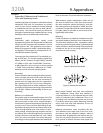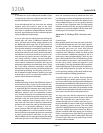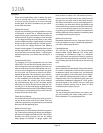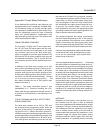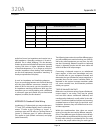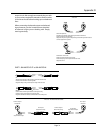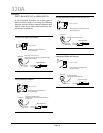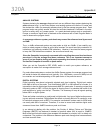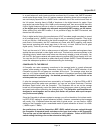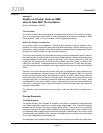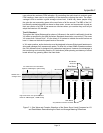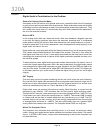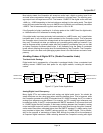
320A
Compellor
Page 34
Appendix E: About Reference Levels
ANALOG SYSTEMS
Systems declaring the average reference level are very different than systems declaring the
peak reference level. In the United States, most analog systems still use the VU meter and
we declare the +4dBu (for example) reference level to be the average program level. Peak
program levels may greatly exceed this level but sufficient headroom is allowed in the elec-
tronics to safely carry any unseen peaks. In a peak declared system such as practiced in
Europe, a maximum signal level is declared as the reference and a Peak Program Meter is
used to observe the program levels.
In an average reference system, peak levels may exceed the reference level by as much
as 20dB.
Thus, a +4dBu referenced system may see peaks as high as +24dBu. If we carefully con-
trolled a mixed program to keep its sound level constant, we would see fairly consistent VU
indications, but extremely variable PPM indications. Likewise, if we mixed the same program
to keep the PPM indications consistent, the sound level would vary.
Since the Compellor is expressly concerned with controlling the sound level as the ear
perceives it, only the average level bears relevance. This is an important concept to
grasp if you are used to dealing with peak responding level meters, because you can-
not see the Compellor’s benefits on peak meters.
When you set the Compellor’s REF LEVEL switch to match your system reference, an
assumption is made of an average reference level.
For peak referenced systems, such as the +6dBu German system, the average program level
will reside far below the reference level (typically 10 to 15dB below, or around -8dBu) but will
be uncertain and variable depending on the peak factor of the particular sound.
DIGITAL SYSTEMS
Digital recording has almost universally adopted peak level metering. Digital level meters
have 0dB at the top of the scale. That is defined as 0dBFS, or 0dB referred to full scale. It is
impossible to have a digital signal that exceeds 0dBFS in peak value. If recording a signal that
frequently peaks to 0dB, it is likely the signal is clipping since it is probable that some of the
peak waveform is “going over the top”. Therefore, it is necessary to keep all signals peaking
below 0dB in a digital system.
There are further constraints on peak levels in digital audio. Any type of digital audio process-
ing can add peak overshoot. Digital effects like reverb or phasing add a lot of overshoot, as do
bit reduction schemes such as MP3. For example. transmission codecs used for ISDN audio
can easily add 6dB of overshoot. Therefore, it is wise to record and maintain digital audio
streams at lower than -6dBFS maximum peak at all times.
In an attempt at dealing with this problem, the Society of Motion Picture and Television
Engineers (SMPTE) has declared a standard of practice where 0VU is equal to -20dBFS.
Most of the world’s audio industry has accepted this standard in principle, but it is widely mis-
understood. The problem is the difference between peak and average level measurements,
and how reconcile them.
Appendix E



